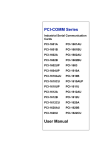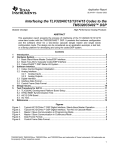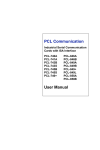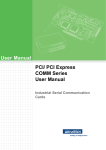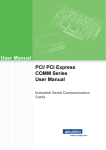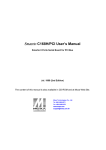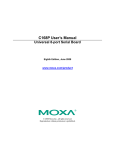Download Advantech PCI-1625U User manual
Transcript
PCI-1625U 8-port Intelligent RS-232 Universal PCI Communication Card User Manual Copyright The documentation and the software included with this product are copyrighted 2005 by Advantech Co., Ltd. All rights are reserved. Advantech Co., Ltd. reserves the right to make improvements in the products described in this manual at any time without notice. No part of this manual may be reproduced, copied, translated or transmitted in any form or by any means without the prior written permission of Advantech Co., Ltd. Information provided in this manual is intended to be accurate and reliable. However, Advantech Co., Ltd. assumes no responsibility for its use, nor for any infringements of the rights of third parties, which may result from its use. Acknowledgements Intel and Pentium are trademarks of Intel Corporation. Microsoft Windows and MS-DOS are registered trademarks of Microsoft Corp. All other product names or trademarks are properties of their respective owners. Part No. 2003162501 2nd Edition Printed in Taiwan August 2005 PCI-1625U User Manual ii Product Warranty (2 years) Advantech warrants to you, the original purchaser, that each of its products will be free from defects in materials and workmanship for two years from the date of purchase. This warranty does not apply to any products which have been repaired or altered by persons other than repair personnel authorized by Advantech, or which have been subject to misuse, abuse, accident or improper installation. Advantech assumes no liability under the terms of this warranty as a consequence of such events. Because of Advantech’s high quality-control standards and rigorous testing, most of our customers never need to use our repair service. If an Advantech product is defective, it will be repaired or replaced at no charge during the warranty period. For out-of-warranty repairs, you will be billed according to the cost of replacement materials, service time and freight. Please consult your dealer for more details. If you think you have a defective product, follow these steps: 1. Collect all the information about the problem encountered. (For example, CPU speed, Advantech products used, other hardware and software used, etc.) Note anything abnormal and list any onscreen messages you get when the problem occurs. 2. Call your dealer and describe the problem. Please have your manual, product, and any helpful information readily available. 3. If your product is diagnosed as defective, obtain an RMA (return merchandize authorization) number from your dealer. This allows us to process your return more quickly. 4. Carefully pack the defective product, a fully-completed Repair and Replacement Order Card and a photocopy proof of purchase date (such as your sales receipt) in a shippable container. A product returned without proof of the purchase date is not eligible for warranty service. 5. Write the RMA number visibly on the outside of the package and ship it prepaid to your dealer. iii CE This product has passed the CE test for environmental specifications when shielded cables are used for external wiring. We recommend the use of shielded cables. This kind of cable is available from Advantech. Please contact your local supplier for ordering information. FCC Class A This equipment has been tested and found to comply with the limits for a Class A digital device, pursuant to Part 15 of the FCC Rules. These limits are designed to provide reasonable protection against harmful interference when the equipment is operated in a commercial environment. This equipment generates, uses and can radiate radio frequency energy and, if not installed and used in accordance with the instruction manual, may cause harmful interference to radio communications. Operation of this equipment in a residential area is likely to cause harmful interference in which case the user will be required to correct the interference at his own expense. Technical Support and Assistance Step 1. Visit the Advantech web site at www.advantech.com/support where you can find the latest information about the product. Step 2. Contact your distributor, sales representative, or Advantech's customer service center for technical support if you need additional assistance. Please have the following information ready before you call: - Product name and serial number - Description of your peripheral attachments - Description of your software (operating system, version, application software, etc.) - A complete description of the problem - The exact wording of any error messages PCI-1625U User Manual iv Packing List Before setting up the system, check that the items listed below are included and in good condition. If any item does not accord with the table, please contact your dealer immediately. • 1 x PCI-1625U • 1 x DB62 loopback for PCI-1625U • ICOM CD-ROM with Industrial Communication Driver, Utility and user manual Safety Precaution - Static Electricity Follow these simple precautions to protect yourself from harm and the products from damage. 1. To avoid electrical shock, always disconnect the power from your PC chassis before you work on it. Don't touch any components on the CPU card or other cards while the PC is on. 2. Disconnect power before making any configuration changes. The sudden rush of power as you connect a jumper or install a card may damage sensitive electronic components. v PCI-1625U User Manual vi Contents Chapter 1 Introduction ..................................................... 2 1.1 1.2 1.3 1.4 Chapter 2 Hardware Configuration ................................ 6 2.1 2.2 Chapter Initial Inspection................................................................ 6 Card Installation ................................................................ 7 3 Driver Setup and Installation....................... 10 3.1 3.2 3.3 3.4 3.5 Chapter Description ........................................................................ 2 Features ............................................................................. 3 Specifications .................................................................... 3 Ordering Information ........................................................ 4 Introduction ..................................................................... 10 Driver Setup .................................................................... 10 Verifying Driver Installation........................................... 17 Removing PCI ICOM Series Device .............................. 20 Driver Uninstallation....................................................... 22 4 ICOM Tools ................................................... 24 4.1 4.2 4.3 4.4 Introduction .................................................................... 24 Installation....................................................................... 24 User Interface of ICOM Tools ........................................ 25 4.3.1 4.3.2 4.3.3 4.3.4 4.3.5 4.3.6 4.3.7 4.3.8 Using the ICOM Tools Utility ........................................ 30 4.4.1 4.4.2 4.4.3 4.4.4 4.5 Menu Bar ..................................................................... 25 Tool Bar ....................................................................... 26 Com Port Tab ............................................................... 27 Port Status .................................................................... 28 Message Logo .............................................................. 28 Tx Slide Bar ................................................................. 29 Performance Listing Area ............................................ 29 Status Bar ..................................................................... 29 Port Selection ............................................................... 30 Figure 4.1:ICOM Tools program window ................... 30 Figure 4.2:Select Port dialog box ................................ 31 Figure 4.3:Ports You Select Will Appear in the Selected Port Checkbox Group ...................................... 31 Figure 4.4:ICOM Tools User Interface ........................ 32 Configuring a Port ....................................................... 32 Figure 4.5:Test Information on the Performance Listing Area .................................................................. 33 Close Port ..................................................................... 34 Exit the ICOM Tools utility ......................................... 34 Messages on Status Bar and Message Logo Area........... 35 4.5.1 4.5.2 Status Bar Messages .................................................... 35 Message Logo Messages ............................................. 36 vii Chapter 5 Pin Assignments & Wiring........................... 38 5.1 Pin Assignments.............................................................. 38 5.1.1 5.1.2 5.1.3 5.1.4 5.1.5 5.2 PCI-1625U ................................................................... 38 Figure 5.1:PCI-1625U RS-232 Mode DB62 Pin Assignment ................................................................. 38 Table 5.1:PCI-1625U RS-232 Mode DB62 Pin Description ................................................................... 39 PCI-1625U with OPT8AP ........................................... 40 Table 5.2:PCI-1625U with OPT8AP Female DB25 Pin Assignment ...................................................... 40 PCI-1625U with OPT8BP, OPT8C ............................. 40 Table 5.3:PCI-1625U with OOPT8BP or OPT8C Male DB25 Pin Assignment ..................................... 40 PCI-1625U with OPT8H ............................................. 41 Table 5.4:PCI-1625U with OPT8H male DB9 Pin Assignment ........................................................... 41 PCI-1625U with OPT8FP ............................................ 41 Wiring.............................................................................. 42 PCI-1625U User Manual Table 5.5:Terminal or PC (DTE) Connections ............ 42 Table 5.6:Modem Connections .................................... 43 Table 5.7:Terminal without Handshake ....................... 43 viii CHAPTER 1 2 Introduction This chapter introduces PCI-1625U, its accessories and detailed specifications. Sections include: • Description • Features • Specifications • Ordering Information Chapter 1 Introduction 1.1 Description The intelligent PCI-1625U 8-port RS-232 interface card was designed for lab and industrial applications where a PC needs to communicate with terminals, modems, or other instruments. You can install up to four PCI1625U cards for a total of 32 ports in any PCI bus-based PC. PCI-1625U is virtually a self contained computer. The PCI-1625U card has an onboard DSP processor that takes over the processing load from the host PC. When you are transferring large amounts of data from multiple ports, servicing the interrupts alone consumes a large percentage of the capacity of your computer's CPU. PCI-1625U serves as a high speed, dedicated interrupt processor. The processor also has 1 MB of SRAM which can store serial data and reduce host CPU loading effectively. When PCI-1625U initializes, it downloads the driver software (which functions like a PC's BIOS) into its onboard DSP. This improves performance and makes version upgrading easy so there is no hardware redundancy. PCI-1625U has a universal PCI connector that is compatible with both newer 3.3 V signaling systems and the traditional 5V signaling system. This gives high compatibility and allows usage in diverse systems. Besides, Advantech provides a convenient utility program, ICOM Tools, to help users test the PCI card performance by analyzing a port’s status. It’s easy to use the menu commands and toolbar buttons. ICOM Tools acts as a PC-based data scope that lets you set a trigger condition, capture the communication data and monitor the signal status. ICOM Tools is applicable to all series of Advantech ICOM cards. PCI-1625U also has many accessories to make usage more convenient. You can use OPT8AP,OPT8ASP,OPT8BP,OPT8BSP, extending module boxes to access 8-port RS-232 devices, or OPT8C and OPT8H, extending cable to access 8-port RS-232 devices, modems and terminals with any kinds of DTE and DCE connection. You could also use OPT8FP to access 8-port RS-422 device, OPT8FP is the RS-422 and RS232 converter connection box. PCI-1625U User Manual 2 1.2 Features • Intelligent 8-port RS-232 serial communication card • Effectively reduce host CPU loading • Speeds up to 921.6 kbps • Onboard 1 MB memory buffer to reduce host CPU loading • High data throughput rate • PCI bus specification 2.2 compliant • PCI universal card (both 3.3 V and 5 V signals) • I/O address automatically assigned by PCI Plug & Play • OS supported: Windows 2000/XP 1.3 Specifications • Processor: TMS320C5402 DSP • Memory: 1 MB • Communication Controller: 8 x 16c550c UART • Serial Interface: 8-port RS-232 • Speed (bps): 50 bps ~ 921.6 kbps • Bus Interface: PCI bus specification 2.2 compliant • IRQ: all ports use the same IRQ assigned by PCI Plug & Play • Data Bits: 5, 6, 7, 8 • Stop Bits: 1, 1.5, 2 • Parity: none, even, odd • Data Signals: TxD, RxD, RTS, CTS, DTR, DSR, DCD, GND • ESD Protection: 16 kV • Dimensions: 175 x 100 mm • Power Consumption: Typical 504 mA, Max 558 mA • Operating Temperature: 0~ 60° C (32~140° F) • Storage Temperature: -25 ~ 85° C (-13~185° F) • Operating Humidity: 5 ~ 95%, relative humidity, non-condensing Note: PCI-1625U does not support RAS service via crossover RS-232 3 Chapter 1 1.4 Ordering Information PCI Intelligent Communication Card • PCI-1625U: 8-port Intelligent RS-232 Universal PCI Comm. Card Accessories • OPT8AP: 8-Port RS-232 Connection Box/Female DB25 Connect (DCE) (1.5 m cable connectors with card and connection BOX included) • OPT8ASP: 8-Port RS-232 Connection Box/Female DB25 Connector w/ Surge protection(DCE) (1.5 m cable connectors with card and connection BOX included) • OPT8BP: 8-Port RS-232 Connection Box/Male DB25 Connector (DTE) (1.5 m cable connectos with card and connection BOX included) • OPT8BSP: 8-Port RS-232 Connection Box/Male DB25 Connector w/ Surge protection (DTE) (1.5 m cable connectors with card and connection BOX included) • OPT8C: 8-Port RS-232 Octopus Cable/Male DB25 Connect 1 m • OPT8H: 8-Port RS-232 Octopus Cable/Male DB9 Connect 1 m • OPT8FP: 8 port RS-422 to RS-232 converter Connection Box with Isolation Protection (1.5 m cable connectors with card and connection box included) PCI-1625U User Manual 4 CHAPTER 2 2 Hardware Configuration This chapter shows how to get started with your PCI-1625U card. Sections include: • Initial Inspection • Card Installation Chapter 2 Hardware Configuration 2.1 Initial Inspection You should find the following items inside the shipping package: PCI-1625U Intelligent communication card, DB62 loopback for PCI1625U, and ICOM CD-ROM with Industrial Communication Driver, Utility, and Intelligent PCI communication card user manual. We carefully inspected the Intelligent PCI communication card series mechanically and electrically before we shipped it. It should be free of marks and scratches and in perfect working order on receipt. As you unpack the PCI-1625U, check for signs of shipping damage (damaged box, scratches, dents, etc.). If it is damaged or it fails to meet specifications, notify our service department or your local sales representative immediately. Also notify the carrier. Retain the shipping carton and packing material for inspection by the carrier. After inspection we will make arrangements to repair or replace the unit. Discharge your body’s static electric charge by touching the back of the grounded chassis of the system unit (metal) before handling the board. You should avoid contact with materials that hold a static charge such as plastic, vinyl and styrofoam. Handle the board only by its edges to avoid static damage to its integrated circuits. Avoid touching the exposed circuit connectors. We also recommend that you use a grounded wrist strap and place the card on a static dissipative mat whenever you work with it When you handle the card, remove it from its protective packaging by grasping the rear metal panel. Keep the anti-vibration packing. Whenever you remove the card from the PC, store it in this package for protection. PCI-1625U User Manual 6 2.2 Card Installation Turn off your PC’s power supply whenever you install or remove the Intelligent PCI communication card or its cables. Static electricity can easily damage computer equipment. Ground yourself by touching the chassis of the computer (metal) before you touch any boards. 1. Turn off the computer. 2. Turn the power off to any peripheral devices (such as printers and monitors). 3. Disconnect the power cord and any other cables from the back of the computer. 4. Remove the PC’s cover (refer to your user’s guide if necessary). 5. Locate the expansion slots or passive back-plane (at the rear of the PC) and choose any unused slot. 6. Remove the screw that secures the expansion slot cover to the PC (save the screw to secure the interface card retaining bracket). 7. Remove the anti-vibration card clamp if supplied. 8. Carefully grasp the upper edge of the Intelligent PCI communication card. 9. Align the hole in the retaining bracket with the hole on top of the expansion slot. 10. Align the gold striped edge connector with the expansion slot socket. 11. Press the board firmly into the socket. 12. Replace the screw in the expansion slot’s retaining bracket. 13. Replace anti-vibration cardholder. 14. Replace the PC’s cover. Connect the cables you removed in step 3. 15. Turn the computer power on. 16. The board is now installed in the computer. See Chapter 5 for information on cabling. 7 Chapter 2 PCI-1625U User Manual 8 CHAPTER 3 2 Driver Setup and Installation This chapter shows how to install, verify and uninstall the driver. Sections include: • Introduction • Driver Setup • Verifying Driver Installation • Removing PCI ICOM Device • Driver Uninstallation Chapter 3 Driver Setup and Installation 3.1 Introduction This chapter describes the driver installation, configuration and removal procedures for Windows operating system, including Windows 2000/XP. We strongly recommend that you install the software driver before you install the hardware into your system, since this will guarantee a smooth and trouble-free installation process. 3.2 Driver Setup Windows 2000/XP supports COM1 to COM256, up to 256 serial ports. The PCI-1625U driver, however, will assign communication ports automatically. In order to fully utilize Windows 2000/XP advanced features such as multi-processing and multithreading, we offer pure 32-bit Windows 2000/XP device drivers for PCI-1625U cards. All these drivers conform to Win32 COMM API standard. Note: We support all 32-bit Windows API but not included IOCTL_SERIAL_SET_QUEUE_SIZE and IOCTL_SERIAL_RESET_DEVICE. PCI-1625U User Manual 10 Steps for Windows 2000/XP Driver Setup Before you install the card into your system, we recommend you install the driver first. Please follow the steps below for the PCI-1625U Windows 2000/XP driver installation. 1. Insert the companion CD-ROM disc into your CD-ROM drive. 2. The driver setup program will be launched automatically. If the auto-play function is not enabled on your system, use Windows Explorer or the Windows Run command to execute autorun.exe on the companion CD-ROM. 3. After the setup program is launched, you.ll see the following screen. 11 Chapter 3 4. Click the Continue button and the catalogue select page appears. Then click the Installation button for installation. 5. Click ICOM Card Drivers for installation. PCI-1625U User Manual 12 6. Choose the driver you want to install, then click the hyperlink. 7. You.ll see the following screen. Click Next to continue installation. 13 Chapter 3 8. Type user name and company name, then click Next. 9. Click Next to accept the default installation folder, or specify a folder by clicking the Browse button. PCI-1625U User Manual 14 10. Confirm the program folder and click Next. 11. Click Back to review or change your setting, or click Next to begin copying files. 15 Chapter 3 12. Click Finish to complete the installation. PCI-1625U User Manual 16 3.3 Verifying Driver Installation After you have installed your card, go to Control Panel/System/Device Manager to look for the Device Name and COM port that are supposed to appear after you have installed the driver. Note: If your device has not been properly installed, there will be an exclamation mark (!) on the device name to indicate a conflicting device. If this is the case, just remove that device and start the driver installation process all over again. After driver uninstall is completed, you must restart your system to re-assign the communication port numbers. You can check the card properties by double-clicking the specific device configuration you want to see. On the General tab, you can see the location information that means your card is installed in which PCI slot on the board. 17 Chapter 3 You can also check the COM port properties by double-clicking the specific COM Port device configuration you want to see. On the Properties sheet, select the specific tabs to see relevant information. On the General tab, you can see if the COM port works properly. If it does, you will see a message under the Device status box, stating, “This device is working properly”. The location shows what COM port is assigned to what port on the card, and helps configure the ports. PCI-1625U User Manual 18 On the Settings tab, you can check relevant information for a specific port. On the figures below you can see which COM port is assigned to which port on the PCI slot. The tab also shows the card model name and FPGA version. In the default communications parameters box, you can set up the bits per second, data bits, parity, stop bits and flow control function. If you click Advanced, it will pop up the dialogue box. You can adjust the COM port number here. 19 Chapter 3 3.4 Removing PCI ICOM Series Device 1. Access Device Manager in the hardware tab system properties. 2. Click the plus sign (+) on the right of the Ports (COM & LPT) device category to expand it. Select the specific “Advantech PCI communication port” you want to remove, and click the Uninstall button to remove the port you have selected. PCI-1625U User Manual 20 Note: 3. Note: You must remove all used ports setting and device setting before you remove the device, or there may be a mistake in the port setting when you install another card. Click the plus sign (+) on the right of the Advantech ICOM Adapters device category to expand it, and select Advantech PCI1625U. We recommend removing the original device settings before installing another model of Advantech PCI ICOM series device in the same PCI slot. 21 Chapter 3 3.5 Driver Uninstallation 1. Insert the ICOM CD and click the driver you want to uninstall. 2. Choose the Modify radio button if you want to save another driver, or choose the Remove radio button to remove all installed components.. 3. Click the Finish button to complete the uninstallation. PCI-1625U User Manual 22 CHAPTER 4 2 ICOM Tools This chapter provides information on installation and usage of ICOM Tools. Sections include: • Introduction • Installation • User Interface of ICOM Tools Chapter 4 ICOM Tools 4.1 Introduction Advantech ICOM Tools is a convenient utility that has been designed to help you test the performance of ICOM cards through analyzing the port status. It features an easy to use graphical user interface that will soon make you familiar with testing via menu commands and toolbar buttons. Advantech ICOM Tools is applicable to all series of Advantech ICOM cards, and can even be used with other third-party ICOM cards. It is included for free on the diskette or on the companion CD-ROM with all Advantech Industrial Communication cards. 4.2 Installation To begin installation, double-click the ICOM_Tools.exe program icon in the Tools folder or click the Advantech ICOM Utility hyperlink in the installation window to launch the ICOM Tools setup program. The setup program will copy the program files to the destination folder you choose or to the default installation path (i.e. C:\Program Files\Advantech\ICOM Tools). A program folder will be created in your Start/Programs menu. (Later you can just access the program through Start/Program/Advantech PCI Comm Tools/COM Examine Tool) PCI-1625U User Manual 24 4.3 User Interface of ICOM Tools 4.3.1 Menu Bar On the Menu Bar you can select various menu commands to perform port-testing functions. You can also use the short-cut keys. Port Submenu Select: Select the ports you want to configure Setup: Setup the configuration of a specific port Close: Close a specific port Run: Run the test on a specific port Stop: Stop the test on a specific port All Ports Submenu Setup: Setup the configurations of all ports Run: Run the test on all ports Stop: Stop the test on all ports Help Submenu Access Online help 25 Chapter 4 4.3.2 Tool Bar Using the Tool Bar buttons is a more intuitive way to implement the functions of ICOM Tools. Port Select: Selects the port(s) you want to perform testing on Port Setup: Sets up configuration of the port you have selected Port Close: Closes the port you have selected Port Run: Runs the port test on the port you have selected Port Stop: Stops the port test on the port you have selected All Ports Setup: Sets up the configuration of all ports not running test All Ports Run: Runs test on all ports All Ports Stop: Stops test on all ports Clear Message: Clears messages on Message Logo area and the Rx length information on the Performance Listing area PCI-1625U User Manual 26 4.3.3 Com Port Tab Each Com Port tab represents a specific port you have selected for test and configuration. On the tab, you can see the Transfer Mode, Port Status, and Message Logo area. Transfer Modes You can specify the transfer mode to be Normal, loopback (active) or loopback (passive). Normal—allows data to be transmitted and received simultaneously. The data reception rate is helpful in identifying the performance of a communication card installed on your system. Loopback- In loopback mode a series of special data will be transmitted, which are expected to appear on the receiving end. Using the loopback mode, you can check the integrity of received data and find whether any error occurred on the transmission line. The active loopback and passive loopback must work in pair to enable the loopback mode. When a port operates as active loopback mode, it will send data first and receive data later. Another port, which operates as passive loopback, will retransmit any received data on the Rx line and then send these data onto the Tx line. These two modes will form a logical loop and help to verify the integrity of data transmitted over the communication link. 27 Chapter 4 4.3.4 Port Status DTR (data-terminal-ready) DSR (data-set-ready) RTS (request-to-send) CTS (clear-to-send) CD (carrier-detect) For RS-232 specifications, DTR and RTS are for output signals and can be toggled on and off by double-clicking the labels (such as DTR, DSR, RTS, CTS, CD) under the red/green marks. However, if you are using RTS/CTS for flow control to run the test, you will see the RTS mark appear in black. This indicates that the RTS can no longer be toggled on/ off since it is controlled by driver itself. A black mark represents that the function is controlled by the driver itself and therefore not controllable by software. 4.3.5 Message Logo On the Message Logo area, you can see the relevant messages about the port(s) you have selected. For information about specific messages in this area, please refer to Section 4.5, Messages on the Status Bar and Message Logo area. PCI-1625U User Manual 28 4.3.6 Tx Slide Bar The Tx Slide Bar allows you to control the overall system loading. You can adjust the transmission rate of your port(s) from 0% to 100%. Just drag the slide button along the track to adjust the transmission rate. 4.3.7 Performance Listing Area On the performance listing area, you can see the relevant information, such as Rx Length (received packet byte length), Bytes/Sec (transmission rate) and Last Abnormal Status of each port running a test. 4.3.8 Status Bar The Status Bar is where you can glimpse the current information of the port you have selected. The Status Bar indicates whether the port is READY, RUNNING, BUSY or STOPPED, N/A PORT and the configuration information such as baud rate, data bit, stop bit, parity bit and flow control (represented as 1200 N 8 1 None) settings. Also we can see the duration of the test in hh:mm:ss format on the right. For information about specific messages on this area, please refer to Section 4.5, Messages on the Status Bar and Message Logo area. 29 Chapter 4 4.4 Using the ICOM Tools Utility To launch the ICOM Tools testing utility, access Start/Programs/Advantech PCI Comm Tools/COM Examine Tools to start the port testing utility. 4.4.1 Port Selection Please follow the steps below to make your port selection: 1. Launch ICOM Tools. You will first see the Program Window such as Figure 4.1. Since you haven’t selected any port for testing yet, all you can see now is a blank window area. Figure 4.1: ICOM Tools program window PCI-1625U User Manual 30 2. Select the port(s) you want to test by the Port/Select menu command or by clicking the Port Select button on the Toolbar, and a dialog box such as Fig. 2 will appear. Figure 4.2: Select Port dialog box Select the port(s) you want to perform test on from the checkboxes next to each COM port. You can either click the checkbox or double-click the name(s) of the port(s) to select/deselect port(s) to perform the test on. The port(s) you selected will immediately appear in the Selected Port field. Figure 4.3: Ports You Select Will Appear in the Selected Port Checkbox Group 31 Chapter 4 Click OK to bring up the ICOM Tools User Interface such as below: Figure 4.4: ICOM Tools User Interface 4.4.2 Configuring a Port You can choose to configure a specific port (or to configure all ports) before running your test. Just click a Com Port Tab to select the port you want to configure, and then click the Port Setup button or use the Port/Setup menu command (or if you want to configure all ports at once, just click the All Ports Setup button or access the All Ports/Setup menu command) to bring up the Configure Port dialog box such as below. PCI-1625U User Manual 32 In the Configure Port dialog box, you can configure the Baud Rate, Data bits, Parity, Stop Bits and the flow control mode for that specific port (or for all ports). After you have configured all the settings you want to change, click OKto make this configuration active. NOTE: When using All Ports Setup button or All Ports/ Setup menu command to configure settings for all ports, you must take care to stop any ports that are running test in order to configure them. If you do not stop the test running on a specific port, it won’t be configured at all. That is, you get to configure only the ports that have been stopped. Run the Test After you have completed the configuration of the port(s), you can now start the test on the port you have selected by clicking the Run button or accessing the Port/Run menu command (or you want to run all ports at once, just click the All Ports Run menu command). button or access All Ports/Run Once the test is started, you can see relevant test information of port performance on the performance listing area. Figure 4.5: Test Information on the Performance Listing Area 33 Chapter 4 The Performance Listing Area Port The com port number Rx length Received packet length in bytes Bytes/Sec Transmission rate in Bytes/Sec Last Abnormal Status Last abnormal status Stop the Test If you want to stop the test on a specific port, just click Port Stop button or access Port/Stop menu command (or if you want to stop test on all ports, just click All Ports Stop command). button or access All Ports/Stop menu You can restart the test by clicking the Run button or accessing the Port/Run menu command (or if you want to run all ports at once, just click the All Ports Run mand). button or access All Ports/Run menu com- 4.4.3 Close Port If you want to close a port, just select the Com Port tab and click Port Close button or access Port/Close menu command to close the port. 4.4.4 Exit the ICOM Tools utility To exit the ICOM Tools utility, simply access Port/Exit menu command or click the Close button on the upper right corner of the program window. PCI-1625U User Manual 34 4.5 Messages on Status Bar and Message Logo Area Messages appearing on the Status Bar and Message Logo area are helpful in understanding specific information of your system settings and performance. 4.5.1 Status Bar Messages BUSY: the port is currently used by another application. FAIL: the configuration parameters are not accepted by the port N/A PORT: the port is not available in the system READY: the port is ready to run or to be configured. RUNNING: the test is running on the port STOPPED: the test running on the port has been stopped by the user 35 Chapter 4 4.5.2 Message Logo Messages Port Opened: The user has opened the port Port Setup Fail: The user has set up the port configuration with parameters that are either incorrect or unsupported. Port Running: The port is running a test Port Stopped: The test is stopped on the port Tx Starting/Tx Stopped: transmitting starting/transmitting stop Rx Starting/Rx Stopped : receiving starting/receiving stop Break Error: a break event has been detected on the port Framing Error: A timing error (i.e. from start bit to stop bit) has been detected on the port Port I/O Error: An incorrect I/O event has been detected on the port Rx Overrun: Received data has been overwritten before being processed Rx Buffer Full Error: The buffer on the receiving end is saturated so that newly arrived data are ignored Tx Buffer Full Error: The buffer on the transmitting end is saturated so that the data transmitted by applications are ignored. LB Error - %d: data error is detected in loop back LB Rx Pending: Loop back mode is waiting for incoming data Data Setup Error: parameter error in port configuration PCI-1625U User Manual 36 CHAPTER 5 2 Pin Assignments & Wiring This chapter shows how the different pins are assigned and how to wire PCI1625U. Sections include: • Pin Assignments • Wiring Chapter 5 Pin Assignments & Wiring 5.1 Pin Assignments 5.1.1 PCI-1625U The following diagram shows the pin assignments for the PCI-1625U card's DB-62 connectors for RS-232. Figure 5.1: PCI-1625U RS-232 Mode DB62 Pin Assignment PCI-1625U User Manual 38 Table 5.1: PCI-1625U RS-232 Mode DB62 Pin Description Pin no. Signal Pin no. Signal Pin no. Signal 1 TxD0 2 DTR0 22 RxD0 23 DSR0 24 DCD0 43 CTS0 44 RTS0 45 GND 3 RxD1 4 DSR1 5 DCD1 25 TxD1 26 DTR1 46 CTS1 47 RTS1 6 TxD2 7 DTR2 27 RxD2 28 DSR2 29 DCD2 48 CTS2 49 RTS2 50 GND 8 RxD3 9 DSR3 10 DCD3 30 TxD3 31 DTR3 32 GND 51 CTS3 52 RTS3 11 RxD4 12 DSR4 13 DCD4 33 TxD4 34 DTR4 55 GND 53 CTS4 54 RTS4 14 TxD5 15 DTR5 35 RxD5 36 DSR5 37 DCD5 56 CTS5 57 RTS5 58 GND 16 RxD6 17 DSR6 18 DCD6 38 TxD6 39 DTR6 40 GND 59 CTS6 60 RTS6 19 RxD7 20 DSR7 21 DCD7 41 TxD7 42 DTR7 61 CTS7 62 RTS7 39 Chapter 5 5.1.2 PCI-1625U with OPT8AP If you choose accessory OPT8AP to connect with PCI-1625U, the female DB25 connectors of OPT8AP are as shown below. Table 5.2: PCI-1625U with OPT8AP Female DB25 Pin Assignment Pin Signal 2 RxD 3 TxD 4 CTS 5 RTS 6 DTR 7 GND 20 DSR 8 DCD 5.1.3 PCI-1625U with OPT8BP, OPT8C If you choose accessory OPT8BP and OPT8C connects with PCI-1625U, male DB25 connectors of OPT8BP and OPT8C are as shown below. Table 5.3: PCI-1625U with OOPT8BP or OPT8C Male DB25 Pin Assignment Pin Signal 2 Txd 3 RxD 4 RTS 5 CTS 6 DSR 7 GND 20 DTR 8 DCD PCI-1625U User Manual 40 5.1.4 PCI-1625U with OPT8H If you choose accessory Opt8H to connect with PCI-1625U, male DB9 connectors of OPT8H are as shown below. Table 5.4: PCI-1625U with OPT8H male DB9 Pin Assignment Pin Signal 1 DCD 2 RxD 3 TxD 4 DTR 5 GND 6 DSR 7 RTS 8 CTS 9 - 5.1.5 PCI-1625U with OPT8FP If you choose accessory Opt8FP to connect with PCI-1625U, you could access RS-422 device through OPT8FP and female DB25 connectors of OPT8FP are shown as below. Pin Signal 2 RxD+ 3 TxD+ 7 GND 14 RxD- 16 TxD- 41 Chapter 5 5.2 Wiring Since the RS-232 interface is not strictly defined, many devices have their own connection methods, which may ignore some signal lines or define reserved lines for other functions. It is best to refer to the user manual of your device for installation instructions. You may find the following helpful. In general, DTE (Data Terminal Equipment) refers to the device that is leading the communication. Examples include PCs, terminals and some printers. DCE refers to the device being communicated with or controlled. Examples include modems, DSU’s (digital service units), printers and lab/factory equipment. In some situations, you may be able to get by with just three lines: data on RxD, TxD and ground. Table 5.5: Terminal or PC (DTE) Connections DB25 Male DB25 Male or Female: Terminal Pin Signal Pin Signal 2 TxD 3 RxD 3 RxD 2 TxD 4 RTS 5 CTS 5 CTS 4 RTS 6 DSR 20 DTR 7 GND 7 GND 20 DTR 6 DSR 8 DCD 8 DCD PCI-1625U User Manual 42 Table 5.6: Modem Connections DB25 Male Modem (DCE) Pin Signal Pin Signal 2 TxD 2 RxD 3 RxD 3 TxD 4 RTS 4 CTS 5 CTS 5 RTS 6 DSR 6 DTR 7 GND 7 GND 20 DTR 20 DSR 8 DCD 8 DCD For DTE to DCE connections, use straight-through cable (i.e., you don't have to reverse lines 2 and 3, lines 4 and 5, and lines 6 and 20 since, in general, the DCE RS-232 interfaces are reversed themselves). Table 5.7: Terminal without Handshake DB-25 Male Terminal, PC (DTE) Pin Signal Pin Signal 2 TxD 3 RxD 3 RxD 2 TxD 4 5 RTS — CTS — 7 GND 7 GND 6 20 8 DSR — DTR — DCD — Therefore, if you are not using CTS, RTS, DSR, DTR and DCD signals, please short pins 4 and 5 together, and please short pins 6, 8, and 20 together. 43 Chapter 5 PCI-1625U User Manual 44




















































